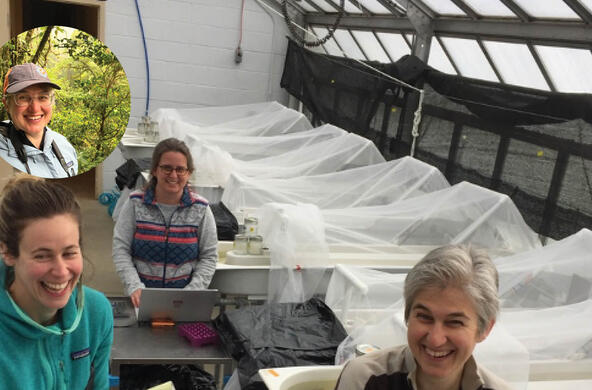Bats carry a number of viruses that sometimes spill over into people. Antiviral medications are our first line of defense and can help our bodies fight off these infections, but a paper by scientists at Cary Institute of Ecosystem Studies and Umea University raises new concerns about whether those treatments will continue to be effective in the future.
Published in April in Environmental Science and Technology Letters, the paper is the first to outline a way that antiviral medications could travel from wastewater to aquatic insect larvae and then bats, whose viruses could then evolve resistance to the pharmaceuticals. Should those viruses then find their way into humans, we would have fewer tools to fight them.
“We really should be careful about manufacturing these compounds and then discharging them into the environment in an uncontrolled fashion,” said lead author Emma Rosi, an aquatic ecologist at Cary Institute. “We don't have an arsenal of antiviral compounds, like we have with antibiotics. We only have about 10 or 20 that we could use as a first line of defense in a pandemic, and so we really need to be careful with them.”
Antiviral medications are growing in use, and the human body doesn’t fully break them down. A person taking Tamiflu, for example, will excrete about 75% of each dose in its active form, and sewage treatment plants will only capture about 5% of those residuals, discharging the rest into lakes and rivers. In many parts of the world, wastewater treatment is basic or nonexistent. Another major concern is that pharmaceutical manufacturing facilities have been known to release high concentrations of antiviral compounds into local waterways.
Once in the waterways, the pharmaceuticals could find their way into aquatic insect larvae such as mayflies, caddisflies, stoneflies, and true flies. Bats are a major consumer of such insects — eating as many as 1,000 in an hour — presenting a pathway of exposure to antiviral compounds that has not been previously explored.

Earlier studies found that drinking water contaminated by antivirals was unlikely to expose bats to high levels of antiviral medications, but the new paper calculates that bioaccumulation — the buildup of contaminants through the food chain — could be more concerning.
In a spatial analysis, the researchers found several areas where diverse bat populations overlapped with high concentrations of pharmaceuticals in waterways, suggesting the bats could be exposed to antivirals.
Furthermore, back-of-the envelope calculations showed that in some cases, bats could be consuming as much as three human doses of remdesivir per day. The dosage varies depending on the antiviral medication’s concentration in the environment, how well it passes from insects to bats, and how many insects each bat species consumes. The extent to which any of these vital factors occur is currently unknown.
Bat populations intermittently exposed to medium-sized doses may pose the highest risk, the researchers note; since the treatments may not be strong enough to completely wipe out the viruses those bats carry, the viruses could have more opportunities to evolve antiviral resistance. Even if this happens rarely, the authors warn that the consequences of even a single occurrence could pose a threat to humans.

The researchers caution that a lot of unknowns remain. There is limited data on antiviral concentrations in waterways, for instance, and how well different antiviral compounds travel through the food chain remains an open question and an area in need of more study.
“There is little doubt in my mind that bats are consuming antivirals,” concluded co-author Barbara Han, a Cary Institute disease ecologist. “It could be they are consuming a very small amount, but this could still be having an impact that we need to understand. More likely, they're consuming quite a lot in some places, probably in the very places that can't afford to have an antiviral-resistant disease emerge in their backyard. I think it's a pretty important thing to not have any data for.”
Both Han and Rosi raised concerns about the difficulty of supporting research into these critical blind spots, in part because they don’t fall squarely into one scientific discipline. For example, the U.S. Food and Drug Administration (FDA) approves medications but doesn’t study their environmental impacts, while the Environmental Protection Agency (EPA) does not regulate pharmaceuticals because they’re not listed contaminants.
The scientists hope that by raising awareness about this concerning and understudied pathway toward antiviral resistance, their paper will provide a first step toward overcoming funding barriers and inspiring other scientists to investigate the many questions that remain.
The paper also lists several calls to action that can help to limit the amount of antivirals released into the environment. Recommendations include restricting antiviral prescriptions to only the most at-risk individuals; monitoring and regulating wastewater from pharmaceutical manufacturers; improving wastewater treatment techniques to more effectively remove pharmaceutical substances; and increasing access to wastewater treatment technologies around the world.
Citation
Emma J. Rosi, Jerker B. Fick, and Barbara A. Han. Environmental Science & Technology Letters 2023 10 (5), 439-445. DOI: 10.1021/acs.estlett.3c00201
Investigators
Emma J. Rosi - Cary Institute of Ecosystem Studies
Jerker B. Fick - Umeå University
Barbara A. Han - Cary Institute of Ecosystem Studies
Related Papers
Richmond, E.K., Rosi, E.J., Walters, D.M. et al. A diverse suite of pharmaceuticals contaminates stream and riparian food webs. Nat Commun 9, 4491 (2018).
Richmond, E. K., Grace, M. R., Kelly, J. J., Reisinger, A. J., Rosi, E. J., & Walters, D. M. (2017). Pharmaceuticals and personal care products are ecological disrupting compounds. Elem Sci Anth, 5, 66.
Almeida Rafael M., Han Barbara A., Reisinger Alexander J., Kagemann Catherine and Rosi Emma J., 2018. High mortality in aquatic predators of mosquito larvae caused by exposure to insect repellent.Biol. Lett.14 20180526.







